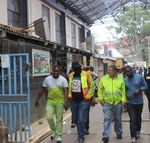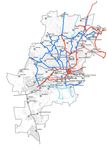CITY OF JOHANNESBURG PRESENTATION TO THE COMPETITION COMMISSION HEARING ON PUBLIC PASSENGER TRANSPORT ENQUIRY 6 JUNE 2018
←
→
Page content transcription
If your browser does not render page correctly, please read the page content below
CITY OF JOHANNESBURG PRESENTATION TO THE COMPETITION COMMISSION HEARING ON PUBLIC PASSENGER TRANSPORT ENQUIRY 6 JUNE 2018
AGENDA
Overview of public transport in the City of
The input today will
Johannesburg (CoJ) complement:
City policy and approach to scope of Introductory meeting
Commission: held with CC officials
Transport planning Submission made in
September 2017
Price setting and price regulation
Response to questions
Route allocation, licensing and entry asked (May 2018
regulations
Strategic Integrated
Operating subsidies Transport Plan
Framework
Transformation
Transport sector planROLE OF CITY OF JOHANNESBURG IN RESPECT OF TRANSPORT Our role revolves around the following strategic thrusts: 1: Restructure and integrate the city through integrated transport planning 2: Improve and expand provision of quality public transport and use of non-motorised transport 3: Maintain, improve, extend and integrate transport infrastructure 4: Support economic growth through improving freight mobility 5: Manage congestion, travel demand and parking 6: Improve transport safety through active, engaged citizenry 7: Transform the transport sector and encourage new, efficient and profitable transport enterprises and green jobs 8: Plan and regulate the transport system 9: Resource and finance the transport plan
INTEGRATED TRANSPORT PLANNING
In line with the NLTA, we have a number of transport
planning instruments to guide infrastructural investment
decisions, operational planning, transformation initiatives
and budget required in the short, medium and long
term.
These include: The integrated public transport
Integrated Public Transport Network Plan network has the following
components:
Transport Master Plans integrating public transport with non- Network hierarchy
motorised transport for regions, precincts or nodes Passenger access typologies
Design parameters
Operational and business plans for services
Tools for integration
City wide strategic networkINTEGRATED PUBLIC TRANSPORT NETWORK (IPTN) HIERARCHY
We have developed a public transport network hierarchy
differentiated in terms of:
Demand
Right of way (and thus speed)
Frequency of stops (depends on demand and surrounding
land use)
Modes (some only one mode e.g. rail, low density areas
can have more than one mode on the network
Degree of investment (for rapid bus, higher investment)IPTN HIERARCHY
MODE
TYPOLOGY DEMAND MODE FUNCTION AND FEATURES
CATEGORIES
o To move people quickly from area of high residential to areas of employment/income
Rail Public Transport SIPTN- Gautrain,
9000-15000 opportunities
Network Type A Metro Rail
o Limited stops. (closed stations)
o Corridors of Freedom, mixed use development , three story residential
Rapid Road Public o To move people quickly from area of high residential to areas of employment/income
SIPTN- Bus Rapid Transport, Light
Transport Network 6000-9000 opportunities
Type B Rail
(High Capacity) o Limited intersections and right turns so buses can be relatively speedy
o Limited mostly closed high or low floor stations
Road Public Transport o Corridors of Freedom and areas where the City want s o densify along the corridor
SIPTN-
Network (Medium 3000-6000 Bus Rapid Transport o Mixed use development, Three story residential, social housing along corridor.
Type C
Capacity) o Fairly frequent closed and opens low floor stations and some stops
o Frequent stops with shelters
Road Mixed Traffic
o Some public transport priority (e.g. queue jumping)
Public Transport IPTN- Bus (Double Decker,
1000-3000 o On street stopping by public transport vehicles
Network (Medium to Type D Standard)
o Low to medium density
Low Capacity)
Road Mixed Traffic
Public Transport IPTN- o Frequent stops with lay bye es and shelters
500-1500 Bus ( Standard, Mini bus)
Network (Low Type E o Low to medium density
Capacity)
Road Mixed Traffic o Low to medium density
IPTN- Bus, Taxi, Demand
Public NetworkSTRATEGIC INTEGRATED PUBLIC TRANSPORT NETWORK With the above assumptions, we have built a transport model that looks at current and future transport demand, population and economic growth and land use On the basis of this model we have identified the key public transport corridors that we need in the City - called Strategic Integrated Public Transport Network These corridors will be operated by rail, BRT, conventional bus and mini bus taxis while recognising a role for demand responsive services.
STRATEGIC INTEGRATED
PUBLIC TRANSPORT NETWORK
Going forward we have divided the City into ‘transport
catchment areas’ and for each catchment area are developing and
then implementing:
Detailed Public Transport Operational Plan setting out the
routes, modes, scheduled and unscheduled services, number
of vehicles per mode, etc..
Infrastructure plan including number of open, closed stations,
interchange, ITS, etc.
Operating Licensing Strategy to include how “seats are
allocated” where new buses replace old buses/taxis and how
OLS will be allocated to existing/new services
Business plans (fundable, bankable, etc.) for implementationREA VAYA
Progress Plans
We have introduced two phases of Rea Vaya BRT:
In line with the shifts above, we are rolling out the third
Phase 1A in 2009 (143 buses, 25 kms of phase of BRT as part of an integrated public transport plan
trunk route) which will include:
Phase 1B in 2013 (134 buses, additional 16 A trunk route (Type B) along Louis Botha and Katherine
km of trunk routes)
between Alex, CBD and Sandton CBD
Passenger numbers are approximately 56 000 per
weekday. Bus routes (Type C and D) from Ivory Park through Mall of
Africa, Sunninghill, Sandton,
Over 600 taxis have been removed from operations,
two bus operating companies (Piotrans and Restructured mini bus taxi routes to connect lower order
Ditsasmaiso) formed with majority shareholding by nodes and provide feeder services
previously disadvantaged mini bus taxi operators
Over 400 ex-taxi drivers now bus drivers of the above Avanzas to provide internal feeder services in Alex and Ivory
companies Park
277 buses procured – with 50% of them meeting local Will be phased in from July 2019 in partnership with
content requirments
affected mini bus taxi and bus operators
Fares are a tariff set by Council after a consultation
process.METROBUS
Role of Metrobus Progress
The CoJ envisages that Metrobus: Metrobus transports less than 50 000 passengers per
day with numbers declining due to lack of sufficient
Will be the primary operator operating on medium buses due to an aging fleet and inadequate fare
demand public transport routes as part of an collection system
integrated network and contracted on a fee/km by the Metrobus routes have mostly not changed over 20
Scheduled Services Management Agency (SSMA) years – servicing mostly former ‘white areas’ with a
limited service from Soweto and no services in other
Have a new bus and fare management system and its ‘townships’ – due to litigation (from PUTCO) and
fares aligned and integrated with Rea Vaya. ‘threats’ (from the taxi industry)
Without sufficient buses and a modern fare collection
system, it is difficult to change the contracting model in
line with what the NLTA envisages.PROVINCIAL SUBSIDISED BUS SERVICES
PUTCO, JR Choeu and others Gautrain buses
The Gauteng Department of Transport operates contracts to Gautrain operates feeder buses (and some mini bus taxis) from
the value of R500 million per annum, mostly from Soweto to its various stations
the North of the City (Sandton, Sunninghill, KayaSands, etc.)
These buses are part of the Gautrain system and passengers
These contracts are poorly managed with an impact on who use them and the Gautrain at a reduced fare. As a result
passengers, the operator and leading to an adverse opinion by relatively few commuters use them without using the train
the AG
As part of our role as defined in the NLTA we have provided
The Province would like the CoJ to take over these contracts ‘direction letters’ to the PRE allowing them to operate until we
as is envisaged by the NLTA but our view is that we can only have an integrated network in that area
take them over if they can form part of an integrated plan and
that affected mini bus taxi operators are given an opportunity Despite significant discussions and disagreement they continue
to be part of such contracts to operate a parallel service to Rea Vaya from Park Station to
Parktown due to the fact that they claim Rea Vaya is not
This requires significant operational and business planning – we reliable enough and there is no air conditioning in Rea Vaya
envisage this is only possible in 3 to 5 years time buses.MINI BUS TAXIS
Approach
The CoJ regards minibus taxis are an integral part of the Issues
transport system and commits the City to improve the The City’s role in regulation of mini bus taxis as required by the
quality and safety of the minibus-taxi routes as part of an
Integrated Transport Network.
NLTA is to provide direction letters in respect of supply and
demand. However in the absence of detailed integrated transport
Our areas of work with mini bus taxis include: plans and due to the ‘time gap’ between transport planning and land
Integration with Rea Vaya BRT system - as part of use development, the City does not believe it can provide credible
the next phase of Rea Vaya we have agreed to assist in direction on supply or demand.
the regularisation of over 5000 taxis in the “North
East Quadrant) There is a significant amount of overtrading and ‘self regulation’ in
Building, maintaining and managing 29 formal public the taxi industry due to relatively low barriers to entry and
transport facilities across the City and attempting to inappropriate regulation
give them a stake in the ‘value chain’ associated with
these facilities
Even if the City were to provide direction on supply and demand, it
is highly unlikely that it could be enforced – even license holders do
Capacity building of association and regional structure not stick to routes on their licenses and most are allocated
leadership through sponsoring a NQF accredited
course at Wits School of Governance
numerous routes
Providing (or not providing) ‘direction letters’ to the The taxi industry is significantly ‘infiltrated’ by criminal elements
PRE in respect of operating licenses which is a major cause of violenceRAIL
PRASA Gautrain
The CoJ has been committed to: We have an operational relationship with the
Support the PRASA rail upgrading and corridor Gautrain including in respect of the management of
modernisation strategy congestion and different operators at Gautrain
Ensuring an integrated network between Gautrain and stations (corporate shuttles, Uber, metered taxis, tuk
PRASA and road based nodes tuks
Working with PRASA for certain rail stations to We have a limited planning relationship with
become intermodal and Transit Orientated
Development (TOD) nodes
Gautrain and their expansion plans in some
instances are not aligned to our land use and
Ensuring that road based modes, pedestrian and cycle transport planning
paths service rail including for so called ‘last mile’
There has been limited progress due to capacity
weaknesses within PRASA and the CityDEMAND RESPONSIVE VEHICLES:
METERED TAXIS, UBER, FOUR PLUS ONE
Issues
Our IPTN Hierarchy makes provision for demand The NLTA requires that we determine the supply and demand of
such vehicles and provide direction to the PRE
responsive vehicles which we regard as including:
As with mini bus taxis, this is inappropriate and can be seen as
Metered taxis: we see Uber and other forms of ehailing as limiting competition – since some of these app based forms of
mobility have created new markets for themselves.
part of metered taxis
The CoJ believes its role is rather to ensure safe mobility for
Four plus one’s: these are often called “Avanzas”,Ventures passengers
and are generally run by mini bus taxi associations for local We would like to see the PRE imposing conditions such as markings
trips in residential areas with a flat fee on vehicles, maps and fare information in vehicles and safety
standards
Tuk tuks: we have provided ‘direction letters’ in certain
In the absence of the PRE making this an operating license
‘niche’ areas such as tourist spots and CBDs (Rosebank, condition, the COJ will include such requirements in bylaws that it
Vilikazi Street, Melville) is revisingLONG DISTANCE AND CROSS BORDER BUSES AND MINI BUS TAXIS
Vision and strategic thrusts Progress
The City’s vision is for long distance and cross border In 2018/19 financial year we will open a new R411 million
facility for cross border buses and all cross border and long
commuters to be able to travel in safety and dignity and distance taxis which will be a catalyst to transform the
that operators are supported to be able to offer provision of such transport for residents and visitors
affordable, quality services while making a decent living.
There will be strict access control which will ensure that
To achieve this vision, the following are the strategic passengers in the facility only board vehicles which are licensed
thrusts: and have passed vehicle fitness tests.
Support the regulation of operators to ensure that There will also be an enforcement plan to prevent loading and
sufficient safe transport exists at affordable prices and holding of vehicles (which are likely be illegal/unsafe) on street
that conflict between operators is reduced; or on illegal land uses.
Provision of quality, safe, accessible ranks for commuters; The City will charge a bay rental fee.
and
Ensuring that the mini bus taxis and buses provide secure,
off-street holding, storage and loading facilities for
themselves.SUMMARY OF CITY’S ROLE IN RESPECT OF OWNERSHIP,
CONTRACTING AND REGULATION
Mode Ownership Contracting Regulating to a limited
extent
Bus Metrobus (This is a Piotrans Long distance buses
municipal owned entity) Litsamaiso Gautrain buses
(These are two private
companies are contracted
to the City to provide Rea (Provincial subsidised
Vaya BRT services) services)
Mini bus taxi N/A N/A Commuter, long distance
and cross border mini bus
taxis.
Metered taxis, app based N/A NA/ Metered taxis, Uber, Taxify,
taxis tuk tuks, AvanzasRESPONDING TO THE COMMISSION
TRANSPORT PLANNING AND COMPETITION
As indicated by the CC in the GG of 10 May 2017: the NLTA is anticipates that integrated transport
planning involves “co-ordinating and organising the different modes of land based transport in a
manner that will result in the different modes of land based public passenger transport complementing
each other as opposed to be alternatives of each other from a consumer perspective”
The City supports this view and for this reason is involved in the transport planning as set out above
to ensure fair competition and no duplication of government subsidies
However there are a number of complexities and unintended consequences as a result of:
Not all public transport is publically owned or contracted by a public body – in particular the mini
bus taxi industry is in private hands and there is very limited contracting of it. The capacity of the
state to thus organise this mode in line with a public transport plan is thus limited
There are three spheres of government responsible for different modes impacting on the same
geographical space, Transport demand is not restricted to municipal boundaries. Johannesburg in
particular receives a large number of trips from surrounding municipalities.PRICE SETTING AND PRICE REGULATION
IN THE CITY
The CoJ is not involved in price regulation of public transport
The CoJ sets prices for Metrobus and Rea Vaya annually as part of the tariff process.
The considerations of the CoJ in setting the fares each year are:
Passenger numbers: current and forecasted
CPI and other economic indicators
Public transport policy that an individual should not spend more than 20% of their disposable income on transport which
therefore suggests that a regressive fare increment will assist the least able to pay to address inequality
Benchmarking the fares against other public transport modes (see next slide)
In respect of Rea Vaya BRT, operators are paid a fee per km and there is an escalation clause to make provision
for increase in fuel, labour, maintenance etc.REA VAYA FARES VS OTHER MODES OF TRANSPORT
Shows that Rea Vaya is
cheaper than all other
modes except
MetrorailROUTE ALLOCATION, LICENSING AND ENTRY REQUIREMENTS
The role of the CoJ in respect of route allocation and providing direction to the PRE in respect of licensing varies
according to different modes as follows:
Metrobus: currently operates on a ‘historical basis’ but the intention is for these routes to be optimised and restructured in line with
the IPTN plan
Rea Vaya: Allocated in terms of a detailed operational and business plan in line with current and anticipated passenger demand
Provincial subsidised contracts: CoJ plays no role, routes operate on a ‘historical basis’ with modifications based on demand and
availability of funding
Gautrain buses: CoJ provided direction letters on request – up until such time as a detailed operational plan is implemented in a
particular area
Commuter mini bus taxi: 2002/3 CITP set out mini bus taxi routes but never implemented. See above in respect of considerations in
this regard.
Long distance and cross border buses and mini bus taxis: CoJ provides direction letters to Cross Border Agency only in respect of
availability of ranking space.OPERATING SUBSIDIES
The following situation exists in respect of the City of Johannesburg:
Metrobus: CoJ provides an operating subsidy to Metrobus in the budgeting process. This covers
70 to 75% of Metrobus operating expenses and the remainder is covered by fare collection
Rea Vaya: Both the CoJ and the National Government through the PTNG subsidies Rea Vaya. The
PTNG pays for specific infrastructure and direct operating costs as per grant submission. The
operating subsidy is about 68% and the remainder is covered by fare revenue. The Bus Operating
Companies are paid a fee per km amount and are charged penalties if they do not perform.
Mini bus taxis: The CoJ provides no direct subsidy to private operators. However access to and
use of public transport facilities such as taxi ranks and holding areas is free which constitutes an
indirect subsidy. The CoJ may provide a subsidy to mini bus taxis in the future if they are contracted
on a performance based contract to provide scheduled services where an operational and business
plan justifies this.TRANSFORMATION
The CoJ has actively promoted transformation, job creation, entrepreneurship development and broad based black
economic empowerment in the public transport sector.
While the focus has been on the mini bus taxi sector, other target beneficiaries are learner transport and small bus
operators
Areas of transformation include:
Broad based black economic empowerment: Facilitating the establishment of two black and predominantly mini
bus taxi owned companies
Job creation: Over 600 taxi drivers have become Rea Vaya bus drivers, 340 staff employed at Rea Vaya Stations
infrastructure creation has led to significant job creation
Value chain; Numerous contracts awarded by Rea Vaya and Metrobus to black owned companies in respect of
fuel, maintenance etc. Work in progress in respect of management, maintenance and advertising of/on public
transport facilities
Capacity building: Pioneered an NQF accredited course for mini bus taxi operators at Wits School of
GovernanceCONCLUDING REMARKS
While the intention of the NLTA is to prevent competition between public transport services, it incomplete and
possible ‘unimplementable’ implementation, has meant that in some areas harmful and unfair competition does
exist.
Areas in the CoJ include:
Mini bus taxi competition with Rea Vaya and Metrobus (including use of the dedicated bus lanes) leads to a loss of fare
revenue which needs to be made up with a greater operational subsidy. Intimidation of bus passengers by mini bus taxi
operators existed but has declined
Duplication of services between Metrobus and Rea Vaya on the one hand and Gautrain on the other – due the Gautrain
requirements for certain frequencies and standards linked to the train service
Lack of regulation by the PRE and City means that the mini bus taxi sector regulate themselves or are ‘regulated by third
parties’ – sometimes with inappropriate sanctions and rewards – and legitimate operators may loose out.You can also read



























































